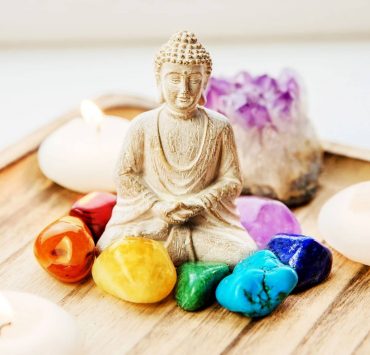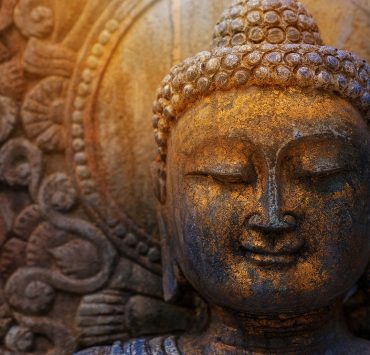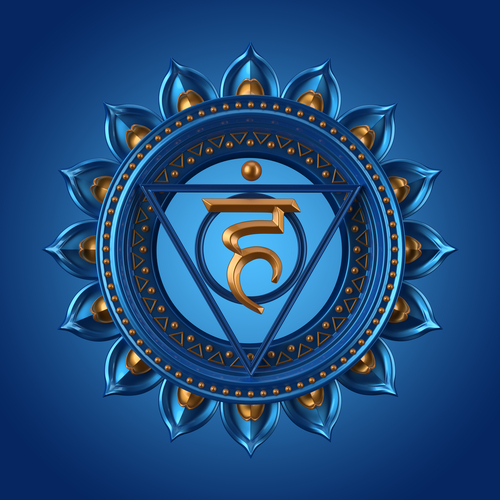
A graduate of Arizona State University, Nicole Baker is a…
Chakras are discussed in yoga and Ayurveda sessions around the world. This rainbow of circles is a complex system that exists in all of us. Chakras are energy centers in the body that are responsible for our health and wellbeing. The main system has seven chakras. Each chakra has a different role and responsibility, affecting our physical, mental, and emotional health.
They are represented by different lotus flowers, with a symbol in the center. These symbols are called yantras. Each chakra is located along the spine and move energy up, down, and through the body. Yantras literally translate to machine and help move Kundalini energy. While its important to keep individual chakras in balance, because each chakra moves energy upward or downward to other chakras, the entire system needs to be tended to.
The seven chakras are as follows:
- Root Chakra (Muladhara): This chakra is responsible for our sense of grounding and foundation. It rests at the base of the spine and helps provides us a feeling of stability and security. When it is in balance, we feel we are able to withstand challenges, when it is deficient we feel unstable. The first chakra is red and is associated with the earth element.
- Sacral Chakra (Swadhisthana): The second chakra helps us manage our emotions with ourselves and with others. Additionally, it is responsible for our creativity and sexual energy. The second chakra is orange and its element is water.
- Solar Plexus Chakra (Manipura): The third chakra is related to our sense of personal power. When it is in balance people feel confident and in control of their lives. When it is blocked, there may be feelings of shame and doubt. However, when there is too much energy here, our own personal needs come at the expense of others. This chakra is yellow and related to the fire element.
- Heart Chakra (Anahata): The fourth chakra connects the lower chakras which are based on our material comforts while the upper chakras relate to spirituality. This green chakra is associated with air. When it is in balance, we can give and receive love freely. When it is blocked, it can be challenging to start or maintain healthy relationships with others.
- Throat Chakra (Vishuddha): The fifth chakra is responsible for our ability to communicate with others. When in balance, we can discuss our thoughts and feelings with others. It is represented by a blue lotus and associated with ether.
- Third-Eye Chakra (Ajna): The sixth chakra is responsible for our intuition, imagination, and wisdom. Located between the eyebrows, this chakra only has two main petals and is purple. It is sometimes seen as a command center for the other elements.
- Crown Chakra (Sahasrara): The seventh chakra is seen as purple or sometimes white. It is considered to be a gateway to consciousness. It connects us to divine energy and enlightenment. Just as our energy moves up through the chakras, energy is received from the diving through the crown chakra and moves it through our systems.
Throat Chakra Overview
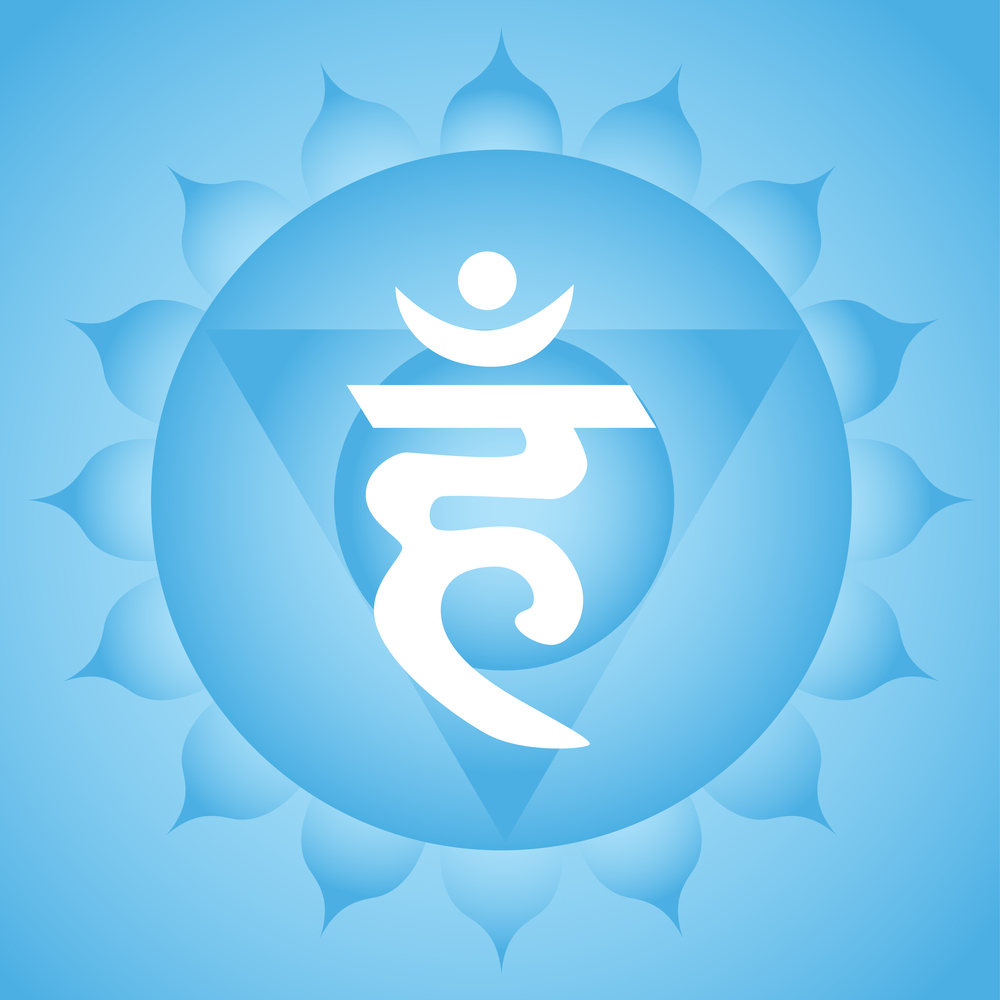
The throat chakra is represented by a blue lotus with sixteen petals and located in the neck region. Ether is its element. While sometimes confused for air, ether is considered a void or anti-matter. Responsible for truth, communication, creativity, and self-expression, when in balance people are able to have a resonant voice. This chakra begins to develop between the ages of seven and twelve years old. To help develop this chakra, parents should encourage creative expression and communication skills.
People with a balanced Vishuddha are typically good listeners, communicate well, and have a good sense of timing and rhythm. It is easy to ask questions and adjust from speaking and listening. They live life with creativity, not bound by fear, and flows through life without agitation.
Issues
The fifth chakra becomes imbalanced when someone is exposed to constant lies and mixed messages, verbal abuse, constant criticism, being forced to keep secrets, exposure to authoritative relationships, and relationships with people who have substance abuse addictions.
Fifth Chakra Deficiencies
When the throat chakra hasn’t been properly developed or is exposed to abuses, it can become deficient. When the fifth chakra is deficient it may show up as excessive shyness, having trouble putting their thoughts into words, inability to express their emotions, voices that are hard to hear, having a fear of speaking, or being tone-deaf.
All chakras are connected with one another. When the throat chakra is deficient is may be difficult to express the emotions radiating from the heart chakra. If the heart chakra is also deficient it may make communicating thoughts or emotions– especially challenging ones, much more difficult. This is usually a result of a person’s upbringing and whether or not communicating their feelings were received well or if they were told to be quiet or feelings were ignored.
Fifth Chakra in Excess
It is also possible for the throat chakra to have excess energy. While some positive traits include being entertaining, charismatic, and entertaining, it may also show up in less positive ways. Symptoms of excess energy are displayed when people gossip, interrupt others while speaking, dominate conversations, and engage in defensive communication.
When the fifth chakra is in excess, a person is trying to dispel the extra energy built up. That results in someone speaking often but with superficial content. They may ramble on with details that are insignificant to the overall thread of the story.
In some cases, there can be swirling energy of excess and deficient symptoms. This is usually seen when people can communicate well with certain people and not others or changes depending on the environment they are in. As there is energy flowing frequently up and down, sometimes a gateway for energy is open allowing the excess and at other times it is closed.
Physical Malfunctions
When there is an imbalance in Vishuddha, it can manifest in the body in a variety of ways. Typically, it will show up near the chakra itself such as tight jaws. The throat, ears, voice, and neck may experience complications or disorders.
Healing Practices
There are many healing practices that can help bring the fifth chakra in balance. Any physical activity that loosens the neck and shoulder area is helpful such as yoga, pilates, dance, or basic stretching. Activities that encourage the use of the throat are also ideal, examples include singing, chanting, pranayama, and storytelling. Writing can also help or any non-goal oriented creative avenues. For some, psychotherapy can be helpful as well.
Sukhasana — Easy Seated Pose with Neck Release Pose

- Start in Easy Seated Pose, Sukhasna.
- Release the right ear towards the right shoulder. Keep the shoulders balanced and hold for five breaths.
- Allow the head to come back to center. Repeat on the left-hand side for five breaths.
- Release the chin down towards the chest. Keep the spine upright and interlace the fingers, resting the hands on top of the head. Do not press down, simply allow the hands to rest. Golf for five breaths.
- Allow the head to come back to center. Release the head back towards the spine. Hold for five breaths with caution.
If you have any neck issues, experience any pain, or see spots come out of these postures.
Marjaryasana — Cat-Cow Pose
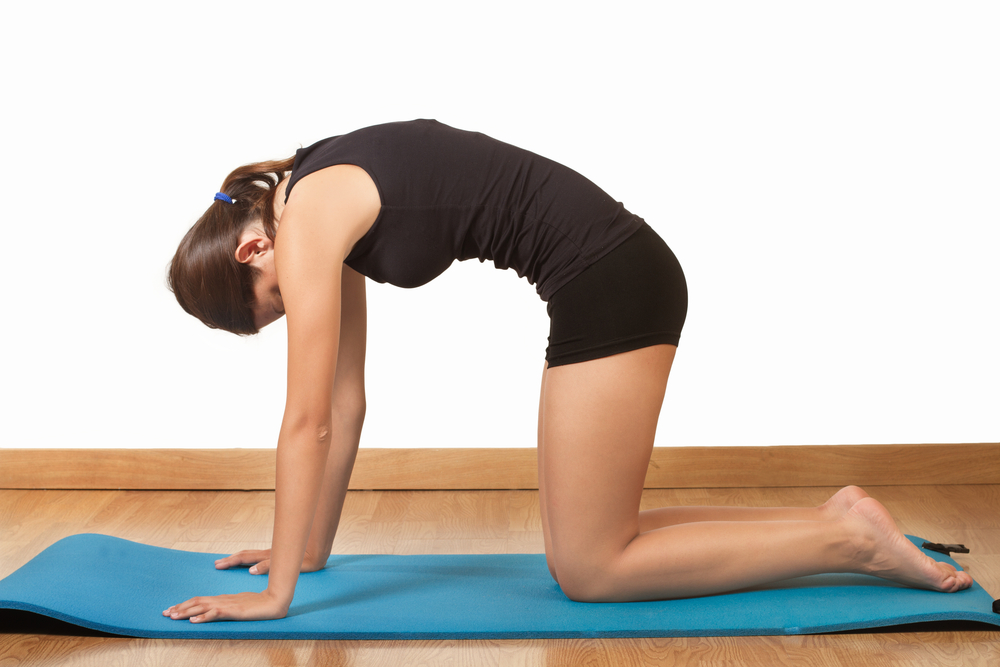
- Start in Table Pose.
- Shift the hips and shoulders forward while keeping the hands in place.
- While gazing in front of you lower the chest and chin down towards the mat while keeping the hips up in the air.
- As you lower, make sure the elbows along the side of the ribcage.
- To come out of the posture, lower onto the belly while sliding the chest forward.
- Come into Cobra Pose. Practice this sequence five times.
Anahatasana — Melting Heart with Chin Variation Pose

- Start in Table Pose
- Walk the hands forward as you lower the forehead down towards the floor or a block.
- Extend the arms forward while allowing the chest to release downward.
- Place the chin on the floor or the block and gaze forward.
- Hold anywhere between five to twenty breaths depending on your ability.
If this doesn’t feel good on the neck, keep the forehead on the floor until you are able to build up.
Halasana — Plow Pose

- Start in a low Bridge Pose with a blanket folded underneath the shoulders.
- Lift the thighs up towards the ceiling while drawing the chin away from the sternum.
- Place your hands underneath the small of the back.
- Lift the feet up towards the sky into a half Shoulderstand.
- Continue to bring the feet back so the toes come onto the floor behind the head.
- Hold between five and ten minutes.
After completing this posture, practice Fish Pose as a counterpose.
Viparita Karani — Legs Up the Wall Supported
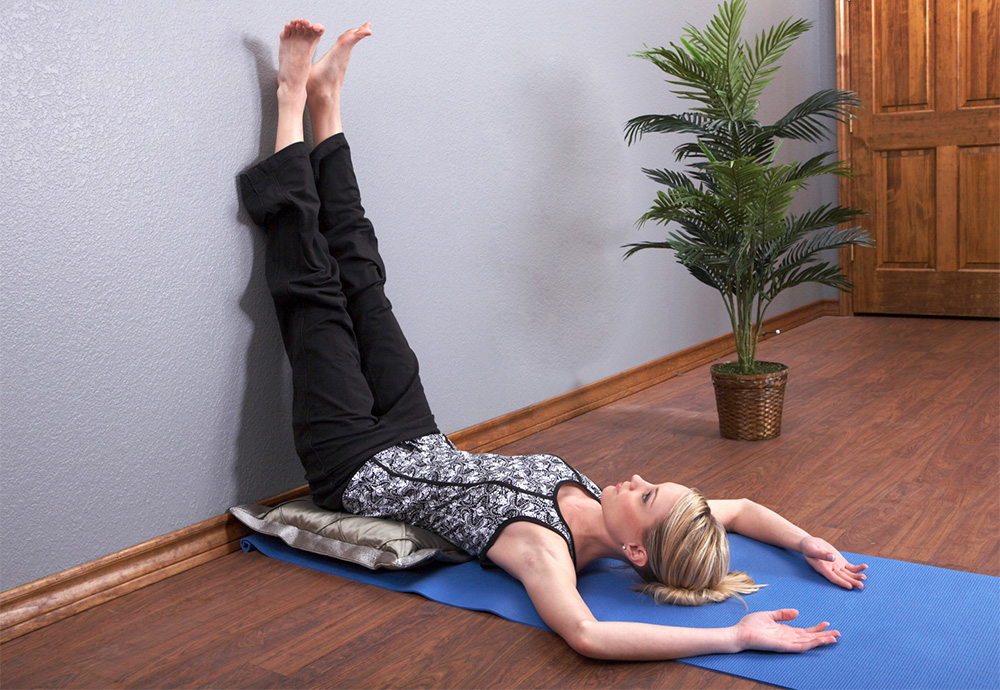
- Place a bolster width wise against a wall.
- Start by sitting on top of the bolster against the wall with your shoulders and outside of the leg closest to the wall.
- Start to bring the legs up the wall as you bring them back towards the floor.
- Lift the hips up and adjust the bolster underneath the small of the back.
- Allow the feet to gently flex and release the arms out to the side in line with the shoulders.
- Hold for three to five minutes.
If you don’t have a bolster or it is too high, you can substitute the bolster for folder up blankets or blocks.
Savasana — Corpse
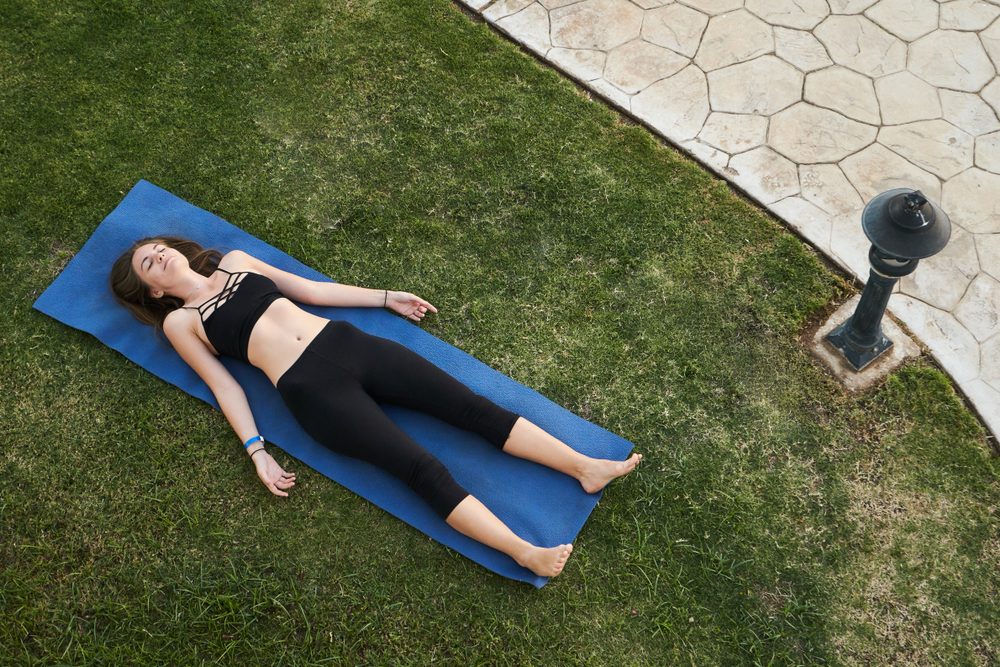
- Come into Corpse Pose.
- Make any adjustments so you feel comfortable and supported.
- Allow time for the experience to integrate.
- If your mind begins to wander, bring your attention to the throat. Notice the breath flowing in and out or any movements or sounds that might be present.
- Practice Savasana for five to twenty minutes.
Pranayama
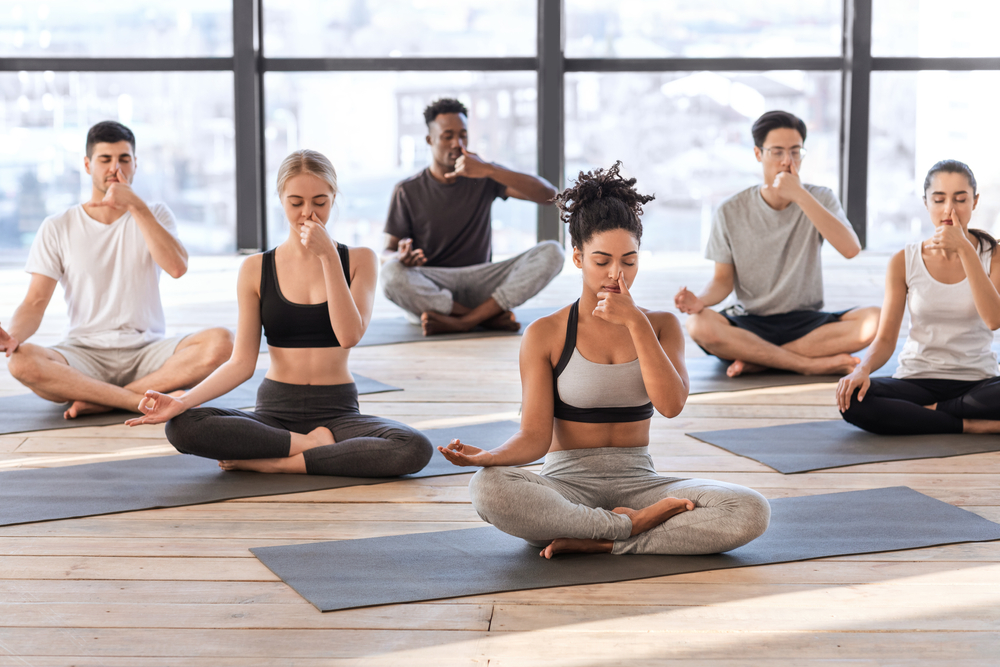
Pranayama can also help bring more energy towards the throat chakra. The Humming Bee Breath or Bhramari pranayama can be soothing towards the body and mind as the awareness is drawn into the breath. The sound of the breath creates a focal point for the mind and the noise can get us comfortable with our own voice.
To Practice:
- Sit in a comfortable position.
- Simultaneously close the eyes and press the fingers over the ears the so sound is muffled.
- The mouth is closed while the jaw is relaxed with the teeth slightly separated.
- Press the tongue gently against the roof of the mouth.
- Inhale and exhale slowly creating a soft humming noise.
- The vibrations come from the soft palette from the top of the back of the mouth.
- Noise should be slow and consistent
- Practice for 2-5 minutes.
Conclusion
The throat chakra helps communicate our thoughts and emotions, creating more fruitful relationships with others. When it is out of balance, try practicing activities, meditation, or pranayama to help bring your chakra system in harmony.
What's Your Reaction?
A graduate of Arizona State University, Nicole Baker is a force to be reckoned with in the realm of health and wellness. She studied behavioral health, which propelled her desire to live holistically and share her knowledge with other like-minded individuals.






